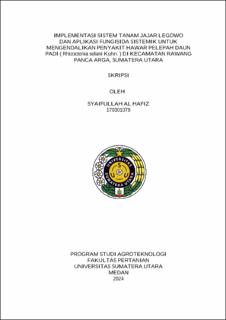| dc.description.abstract | Rice is a plant that is classified as an important commodity in Indonesia. One of the obstacles in rice cultivation is the attack of various kinds of fungi, including the fungus Rhizoctonia solani Kuhn. cause of sheath blight. One control that can be carried out is regulating planting patterns, using systemic fungicides and administering appropriate doses. This study aims to determine the effectiveness of several active ingredients of systemic fungicides and systemic fungicide application intervals in the 2:1 and 4:1 jajar legowo planting systems in suppressing the development of rice leaf sheath blight disease in Rawang Panca Arga District, Asahan Regency, North Sumatra Province. This research was conducted in the endemic area of rice leaf sheath blight disease in Rawang Panca Arga District, Asahan Regency, North Sumatra Province from June 2021 to September 2021. The research method used was using Separate Plots Design (RPPT) using 3 factors namely planting system (main plot) L1 (Legowo 2:1) and L2 (legowo 4: 1), fungicide active ingredients (subplots) F1 (Mankozeb 80%), F2 (Tebuconazole 50%+Trifloxystrobin 25%), F3 (Difenoconazole 250 g/l), F4 (Carbendazim 80%), and fungicide application interval (subplots) K1 (2 gr/4 days), K2 (3 gr/6 days) and K3 (4 gr/8 days). The results of this research is Jajar Legowo 4:1 and Difenoconazole are the most effective treatments for suppressing the development of the R. solani fungus with the lowest average severity is 0,05% at 45 dap and 1,13% at 60 dap. And the combination of treatments are legowo 4:1, fungicide Difenoconazole with an application interval of 2 gr/4 days is the best combination that is able to suppress the development of R. Solani with the lowest average severity is 0.02% at 55 dap and and maintaining good production results. | en_US |


